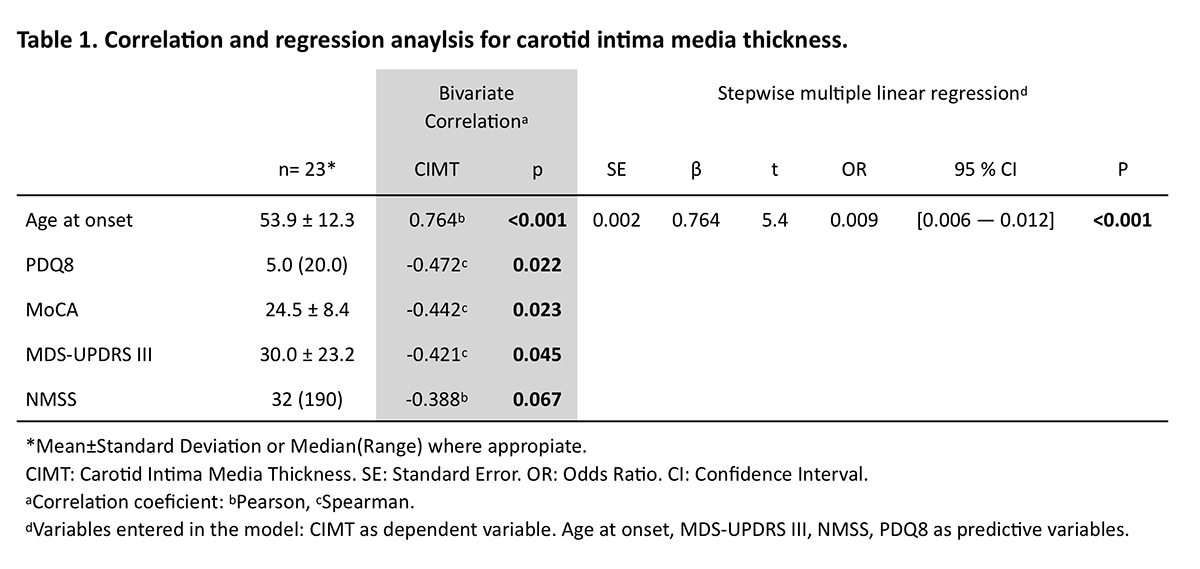Session Information
Date: Tuesday, September 24, 2019
Session Title: Parkinsonisms and Parkinson-Plus
Session Time: 1:45pm-3:15pm
Location: Agora 3 West, Level 3
Objective: To determine the clinical correlates of carotid intima media thickess in patients with idiopathic Parkinson’s disease (PD).
Background: Subclinical cardiovascular disease has been suggested to influence the phenotype and course of Parkinson’s disease [1, 2]. Carotid Intima Media Thickness (CIMT), is a non-invasive marker of subclinical atherosclerosis, that in PD patients has been associated with disease severity[3], and decreased survival[4].
Method: Patients with PD diagnosis were recruited from the movement disorder outpatient clinic. CIMT was measured as the mean average of bilateral common carotid artery along 20mm; disease was evaluated with severity (Hoehn & Yahr, H&Y), cognitive (MoCA), motor (MDS-UPDRS III), non-motor (NMSS) and quality of life (PDQ8) scores; and bivariate correlations were sought with CIMT. Stepwise linear regression analysis was performed using CIMT as dependant variable.
Results: 23 patients were included, 52% (n= 12) female, mean age 60.1±11.8; mean H&Y stage 1.7±0.9, with stage 1 being the most common (65%, n= 15), mean disease duration 6.5±4.1 years, and disease onset at 53.9±12.3 years. Mean CIMT was 0.673±0.144 mm. We found significant correlations with age at onset (strong), MDS-UPDRS III, MoCA and PDQ8 (moderate). Stepwise regression analysis found that only age at disease onset was a significant predictor for CIMT. Details are given in table 1.
Conclusion: In Parkinson’s disease, age at onset is an independent predictor of CIMT. Higher CIMT was correlated with worse cognitive status and quality of life; whereas higher motor and non-motor severity were correlated with lower CIMT. Although this might suggest subclinical atherosclerosis might have a protective effect on motor and non-motor severity, larger studies are required to determine the relationship between cardiovascular disease and PD. Our results are preliminary, as patient recruitment is ongoing.
References: 1. Rektor et al. Parkinsonism Relat Disord. 2009;15(1):24-9. [DOI: 10.1016/j.parkreldis.2008.02.007] 2. Malek et al. Mov Disord. 2016;31(10):1518-26. [DOI: 10.1002/mds.26698] 3. Nakaso et al. J Neurol Sci. 2003;207(1-2):19-23. [DOI: 10.1016/S0022-510X(02)00353-2] 4. Rektor et al. Mov Disord. 2012;27(9):1169-72. [DOI: 10.1002/mds.25066]
To cite this abstract in AMA style:
S. Castillo-Torres, C. Soto-Rincón, D. Cantú-García, A. Mendoza-Garcia, D. Díaz-Pérez, D. Martínez-Roque, B. Chávez-Luévanos, I. Estrada-Bellmann, F. Góngora-Rivera. Carotid Intima-Media Thickness and its correlates in people with Parkinson’s disease: a pilot study [abstract]. Mov Disord. 2019; 34 (suppl 2). https://www.mdsabstracts.org/abstract/carotid-intima-media-thickness-and-its-correlates-in-people-with-parkinsons-disease-a-pilot-study/. Accessed December 30, 2025.« Back to 2019 International Congress
MDS Abstracts - https://www.mdsabstracts.org/abstract/carotid-intima-media-thickness-and-its-correlates-in-people-with-parkinsons-disease-a-pilot-study/

